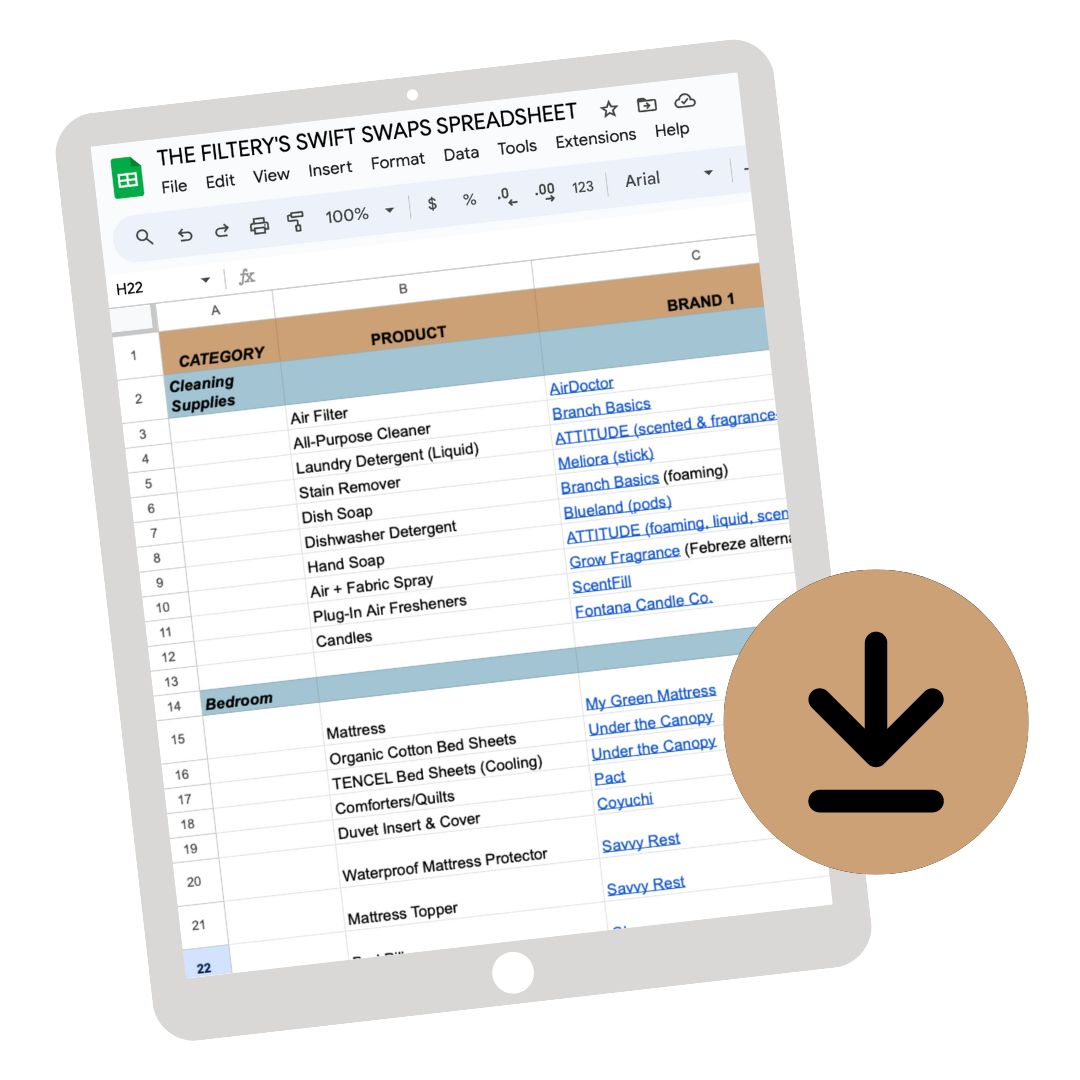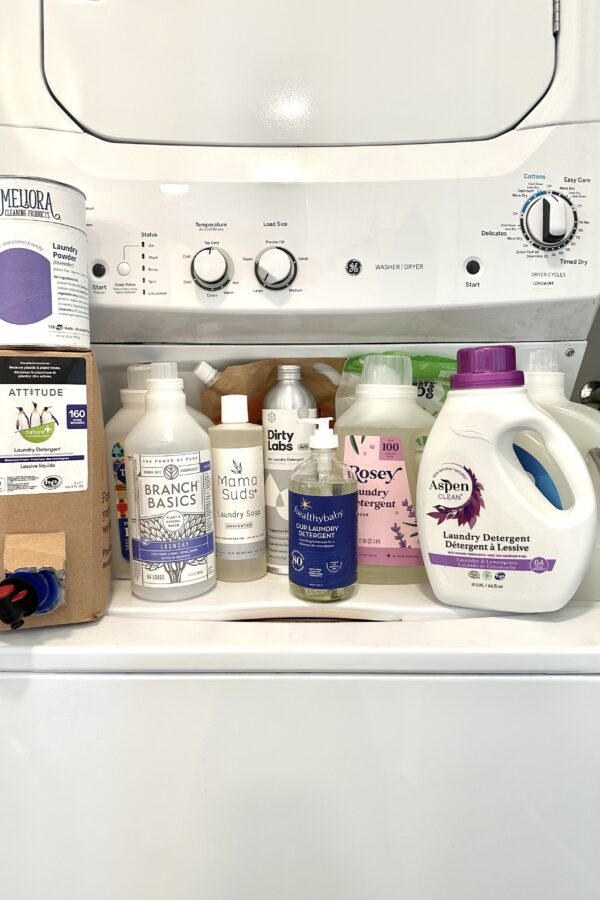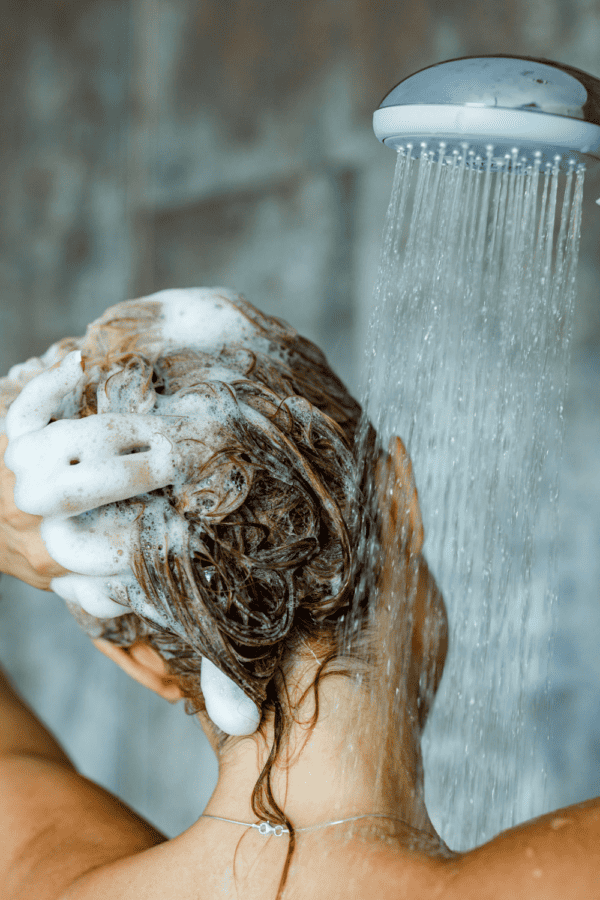In a Nutshell:
- Most fertilizers (both commercial and domestic) are made with biosolids.
- Unfortunately, most biosolids are contaminated with a number of toxicants, including PFAS “forever chemicals.” (This includes many “organic” fertilizers, too!)
- 2021 testing by the Sierra Club and Ecology Center found PFAS in various brands of home garden fertilizers and soil amendments.
- It’s extremely difficult to find pre-made fertilizer that has both been tested for low levels of PFAS and is still available on the market.
- That said, my top choice for garden fertilizer that’s been tested to have the lowest amount of PFAS is New Plant Life’s Mushroom Compost.
- Scroll down for more tips on how you can reduce PFAS in your garden by going the DIY route!
Are you like millions of people growing fruits and vegetables in home or community gardens because they’re healthier for you and your family? Unfortunately, they may not be as healthy as you think when the home fertilizer or soil amendment you use on your garden is contaminated with PFAS chemicals.
Increasingly in our industrialized society, over 15,000 per- and polyfluoroalkyl substances (PFAS)—which are used legally in everything from firefighting foams to non-stick pans, dental floss to carpet cleaners—are spilling over into drinking water, air, soil, and food.
The problem is, there are so few products that are actually tested for PFAS that you’re left in the dark. It’s extremely difficult (sometimes impossible!) to know whether a specific product contains PFAS or not.
In this article, I clear up some of the mystery surrounding hidden, largely untested PFAS in garden fertilizers and soil amendments for domestic use. Using two reliable sources that conducted independent laboratory testing, I list a few brands which have been confirmed to contain very little PFAS chemicals.
I also identify brands of home garden fertilizers and soil amendments composed of biosolids, which have been tested to contain significantly higher levels of PFAS.
To avoid PFAS being absorbed from contaminated soil into your fruits and vegetables, I recommend that you avoid all gardening products containing biosolids. I’ll get into this more in a minute.
Fortunately for gardeners striving to be as PFAS-free as possible, there are plenty of alternative ways to enrich your soil without commercial products, so you’ll be rewarded for your efforts with a bumper crop of nutritious produce. I suggest a few below.
Table of Contents
- Why Are PFAS Bad?
- What Are Biosolids?
- Lawsuits Related to Biosolid PFAS Contamination
- How Can I Tell if Home Garden Fertilizers and Soil Amendments Contain Biosolids?
- Do PFAS-Free Fertilizer and Soil Amendments Exist?
- Summary of Studies on PFAS in Home Garden Fertilizers and Soil Amendments
- My Top Pick for Garden Fertilizer with the Lowest Amount of PFAS
- What About Other Alternatives, Like Liquid Fish Fertilizer?
- Alternative Ways to Improve Garden Soil Quality Without Store-Bought Fertilizers
- 1. Make your own fertilizer.
- 2. Plant native species in your garden.
- 3. (Try) to use PFAS-free irrigation if possible.
- Key Takeaways on PFAS-free Home Garden Fertilizers
This article contains affiliate links, which means we may earn commission if you decide to make a purchase.
Why Are PFAS Bad?
As I detailed in other articles, including ones on PFAS-free clothes irons and PFAS-free hair curling irons, PFAS as a general class of industrial chemicals are associated with multiple adverse health outcomes. Even small amounts of individual compounds can lead to cancer, hormonal disorders, and autoimmune conditions, to name just a few.
Other negative health effects from PFAS exposure are being discovered regularly as more research is being done.
Scientists are just beginning to understand the effects of “PFAS cocktails”—several different PFAS chemicals—on human and environmental health. There is evidence that the chemicals may work in combination to increase health risks even more.
PFAS are called “forever chemicals” because they remain largely unchanged in your body or the environment for decades, if not longer. The cumulative effects of a high PFAS body burden are not completely understood. It is best to avoid PFAS exposure as much as possible in a world where they are practically everywhere.
For home gardeners, a major way PFAS enter your garden is from fertilizer and soil amendment contamination. The key culprit in these products is called biosolids.
What Are Biosolids?
Often deceptively marketed as “green,” biosolids are anything but eco-friendly or healthy. Biosolids are the dried human feces leftovers combined with industrial wastewater chemicals after water has been treated and diverted at wastewater plants.
While almost all waterborne bacteria, viruses, and protozoa had been killed during various water treatments, residual toxic chemicals like PCBs, flame retardants, pharmaceuticals, and heavy metals wind up in the solid waste. PFAS are included in the mix, too.
Because landfilling this human sewage sludge is expensive and often deemed too hazardous to dump (since toxic leachate eventually contaminates groundwater), treatment plants frequently sell it to farmers to spread on their fields or package it in bags and sell it as lawn or garden fertilizer.
The exact chemical composition of a particular batch of sludge varies from day to day and from place to place. Although a few states test for certain chemicals in sludge, biosolids are spread on cropland or sold as home fertilizer without undergoing any strict regulation or treatment to remove toxic substances.
If you’re thinking that spreading biosolids on farm fields and gardens might be hazardous to human health, you’re right. Here are just a few cases of the adverse events that occurred in numerous states:
- Maine dairy farmers, on fields treated with biosolids, had to shut down when milk was found to contain high levels of PFAS. Farmers’ blood tested for PFAS also showed high levels.
- Surveys of people in North Carolina, South Carolina, and Virginia living close to biosolid-treated fields report burning eyes, nausea, vomiting, boils and rashes.
- In Georgia, cows eating hay grown in biosolid-treated fields died.
- A Michigan farm was shut down because of PFAS contamination in cattle, land, and water from PFAS-tainted fertilizer.
- Farmers in Texas claim they and their livestock have been experiencing a range of new health issues (including animal deaths) after their neighboring farm spread a large amount of PFAS-laden fertilizer on their land.
The United States Environmental Protection Agency (USEPA) has launched a risk assessment on PFAS in biosolids. A final report is expected at the end of 2024.
Until then, home gardeners are truly on their own.
Lawsuits Related to Biosolid PFAS Contamination
The good news is that the first lawsuit brought by farmers against Synagro, a major company managing 6.5 million tons of biosolids yearly, was filed in February 2024.
This lawsuit comes from the Texas farm referenced above. The plaintiffs claim that absurdly high levels of PFAS contaminate their soil and livestock. The contamination originated from Synagro biosolid products.
For instance, the lawsuit indicates 610,000 parts per trillion (ppt) of PFOA, a banned PFAS, was tested in a stillborn calf. (For reference, the USEPA’s proposed drinking water standard for PFOA is 4 ppt.)
Simultaneously, the nonprofit Public Employees for Environmental Responsibility (PEER), filed a lawsuit against USEPA charging it with concealing information on PFAS as a trade secret.
How Can I Tell if Home Garden Fertilizers and Soil Amendments Contain Biosolids?
To the best of my knowledge, the term “biosolids” should appear on a package composition label if they are present.
You will likely find the phrase “organic fertilizer” on the label, too, leading you to believe it’s a healthy, non-toxic product. You will not find anything about the sources of biosolids: human feces and industrial wastewater.
Biosolids may have been treated by air drying or pasteurization at wastewater treatment plants. These techniques kill most pathogens. Unfortunately, neither of these methods involve removing toxic chemicals from the sludge.
Do PFAS-Free Fertilizer and Soil Amendments Exist?
In 2021, the nonprofits Sierra Club and the Ecology Center conducted an analysis of several home garden fertilizers and soil amendments. They were searching for PFAS-free garden products.
In 2020, a group of researchers did a similar study of home gardening products to compare PFAS levels in fertilizers containing biosolids with those which did not have biosolids.
The studies showed high levels of multiple PFAS in home garden fertilizers and soil amendments made with biosolids, but very little PFAS in products containing no biosolids.
However, of the brands tested, no commercial garden fertilizer was completely PFAS-free.
Food Packaging’s Contribution to PFAS in Compost
The 2020 study linked above included a product containing food and food packaging compost taken from the organic fraction of municipal solid waste.
Source: Choi, et al. (2019)
In this case, since the U.S. Food and Drug Administration (USFDA) permits some PFAS in food packaging, higher levels in the compost is understandable.
(Good news! The FDA just announced that manufacturers have agreed to voluntarily phase out PFAS in food packaging. So, this source of PFAS in home and organic municipal compost should decrease over time, but it won’t happen overnight. In the meantime, avoid municipal organic compost unless you’re sure it contains no food packaging.)
But certified organic fertilizers are safe, right?
Not necessarily, but it depends.
Third-party certifications such as ORMI do not currently have requirements or restrictions on PFAS specifically. That said, they do have restrictions on the use of biosolids. So while “certified organic” fertilizers may not be guarantee to be “PFAS-free,” they may be better than alternatives.
Summary of Studies on PFAS in Home Garden Fertilizers and Soil Amendments
The Sierra/Ecology Center Report summarized their findings on nine home fertilizers made with biosolids that contained PFAS levels exceeding a land application standard in Maine, the state with the strictest regulations for agricultural products likely contaminated with PFAS.
The brands they analyzed were:
- Cured Bloom
- TAGRO Mix
- Milorganite 6-4-0
- Pro Care Natural Fertilizer
- EcoScraps Slow-Release Fertilizer
- Menards Premium Natural Fertilizer
- GreenEdge Slow Release Fertilizer
- Earthlife Natural Fertilizer
- Synagro Granulite Fertilizer Pellets
The Sierra/Ecology Center Report noted:
“Of the 33 PFAS compounds analyzed, 24 were detected in at least one product. Each product contained from 14 to 20 detectable PFAS compounds. Additional tests showed they also contained two to eight times greater mass of precursor compounds and hundreds to thousands of times more unidentifiable synthetic fluorine compounds.”
In other words: they found high levels of PFAS in all of the fertilizer brands they tested.
For this reason, I recommend that you avoid these brands of home garden fertilizers and soil amendments.
Here is a list, compiled from the 2020 journal article linked above, of home garden fertilizers and soil amendments made without biosolids. Testing revealed small quantities of PFAS:
- EKO Organic Compost Soil (this is the only distributor I’ve been able to find where you can order this product online)
- Gardener’s Pride Composted Manure (unfortunately, this company appears to now be bankrupt)
- New Plant Life Composted Manure (not currently available at retailers, unfortunately)
- New Plant Life Mushroom Compost (available from retailers here, here, here, and here)
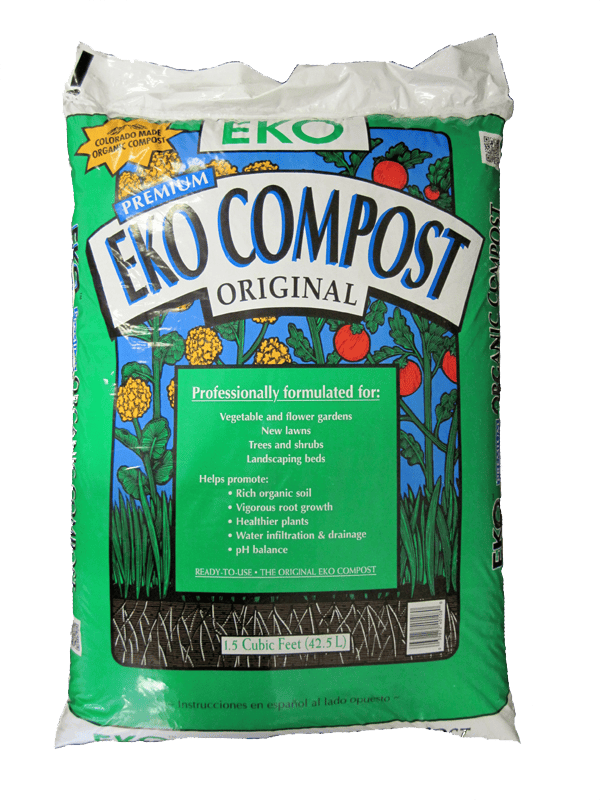

Here is an infographic which illustrates this study’s results. Tested PFAS appear in the right column.

Source: Virginiabiosolids.com
In researching this article, I also identified Nantucket Natural Compost to add to this list of home garden products containing little to no PFAS among those tested for.
This product was tested for PFAS according to Massachusetts law. (In most states where there is no PFAS regulation of agricultural products, companies do not test for PFAS, as a few brands told me during research for this article.)
However, I unfortunately was not able to find any brands that are actually available for purchase online that use Nantucket Natural Compost (co-compost).
My Top Pick for Garden Fertilizer with the Lowest Amount of PFAS
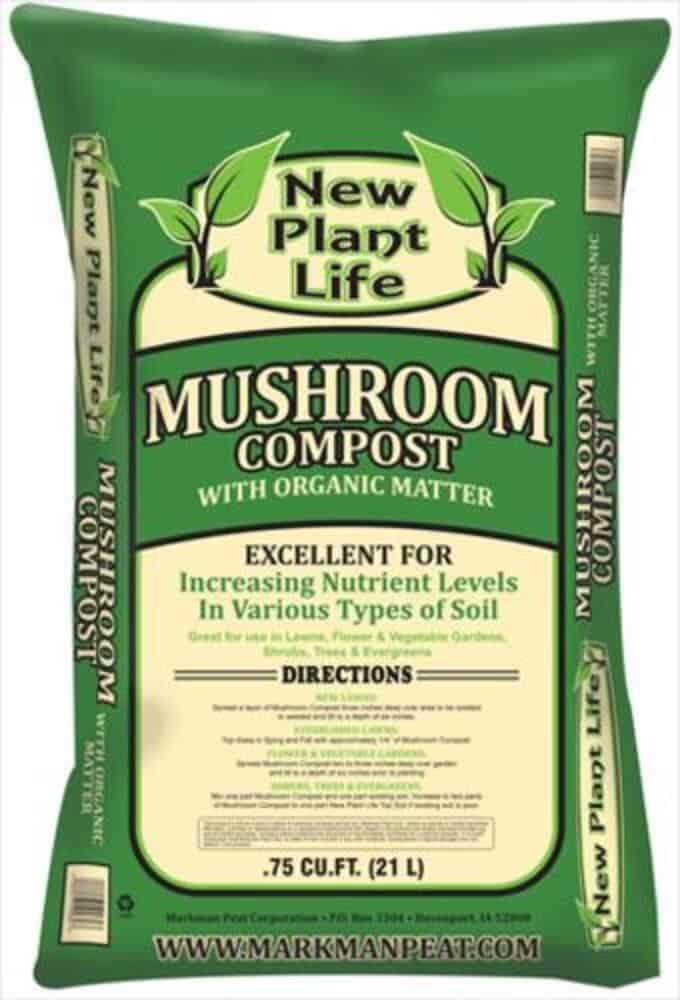
If you really wish to use a commercial natural fertilizer on your garden, at least the five products noted in this section’s preceding paragraphs have undergone some level of PFAS testing and show low levels.
However, as you can see, the products that tested for the lowest amount of PFAS in this study are quite difficult to find. Therefore, my top pick for an (almost) PFAS-free fertilizer is New Plant Life’s Mushroom Compost, which can be found in certain big box stores like Menard’s.
You also may be able to find it at a few other reatilers (like here, here, and here).
What About Other Alternatives, Like Liquid Fish Fertilizer?
You may be wondering if products like Neptune’s Harvest may be a good alternative. They make a variety of liquid fertilizers that are made out of things like fresh fish, seaweed, molasses, and yucca extract. (In other words: not biosolids.) Additionally, many of them are ORMI listed, which means they’re certified to be suitable for organic gardening.
We emailed Neptune’s Harvest to ask if they test for PFAS and they told us that they do test for many different types of contaminants (they even shared their test results); however, PFAS is unfortunately NOT one of the contaminants they test for.
So at this time, while Neptune’s Harvest is probably a better option than many when it comes to the best organic fertilizers when it comes to PFAS specifically, we don’t actually know anything about its PFAS content.
That said, there’s another issue when it comes to fish-based fertilizers: microplastics. Fish tend to accumulate microplastics and other toxicants (and it gets worse as you move up the food chain). Unfortunately, it doesn’t appear that Neptune’s Harvest tests for microplastics either, which is definitely not ideal.
You’ll have to take all of this into consideration when deciding whether these types of fertilizers are the “best” option for you.
Alternative Ways to Improve Garden Soil Quality Without Store-Bought Fertilizers
1. Make your own fertilizer.
If you want to minimize PFAS in your home garden fertilizer, consider creating your own compost using food scraps and paper packaging that has not been coated with PFAS. You may add leaves and grass clippings as long as your water source is PFAS-free.
- To maximize your success, use only food scraps from USDA 100% certified organic fruits and vegetables or those you’re sure are grown without biosolid applications. I personally have had much success with this method.
- If you choose manure, make sure it’s from rabbits or chickens fed with certified organic fruits, vegetables, or grains. Horse and cow manure could contain PFAS if the animals had been fed hay grown with biosolids.
- If you’re not sure, get to know your county extension agents and master gardeners who may be able to recommend local farmers who are not using biosolids.
- Also, 4-H groups may have some members raising rabbits or chickens organically with plenty of manure to give away!
2. Plant native species in your garden.
Another good idea is to plant native species of plants in your garden. In general, natives do not need fertilizers to grow unless they’re showing yellow foliage. Those that produce rhizomes, such as native milkweed, infuse usable nitrogen in the soil via nitrogen fixation and spread out underground while doing it.
So, these species are a win for pollinators and a win for your garden!
3. (Try) to use PFAS-free irrigation if possible.
It’s important to avoid bringing anything grown with irrigated groundwater contaminated with PFAS to your compost pile.
Unfortunately, confirming this is practically impossible. Your best bet is to use local sources. Contact your local department of environmental quality to determine if there is PFAS contamination of groundwater in local farm fields or biosolid application that could theoretically spread and contaminate what otherwise is PFAS-free produce or chicken manure that you would like to use as home fertilizer.
Key Takeaways on PFAS-free Home Garden Fertilizers
PFAS chemicals are literally everywhere in modern society—including in food, water, air, and soil. If you’re a backyard or community gardener, there are a few steps you can take to reduce the occurrence of these forever chemicals in the fruits and vegetables you have tended all season.
Although a few states require that agricultural products and irrigation water be tested for PFAS, the lack of federal regulations (let alone enforceable requirements) to remove PFAS from soil, water, or similar gardening essentials means you grow and consume food at your own risk.
As I’ve discussed in this article, it is now well-known that biosolids used in many home garden fertilizers and soil amendments are contaminated with high levels of PFAS. When you add them to your garden, plant roots quickly absorb and retain these forever chemicals. If you eat your garden’s bounty, then you will be adding to your body burden of these hazardous chemicals.
So, if you can, try to avoid all garden fertilizers and soil amendments containing biosolids.
Basing my recommendations on independently-tested products shown to have little PFAS, I list a few commercial brands of home garden fertilizers here.
If you’d like to use alternatives to store-bought home garden fertilizers and soil amendments, I offer several natural product ideas to boost soil quality. Although they could also—unknowingly—contain PFAS, selective addition of components will provide you with greater control over what’s in contact with your plants’ roots. At the end of the planting season, a toxic-free garden harvest will be worth it for you and your family’s health.
